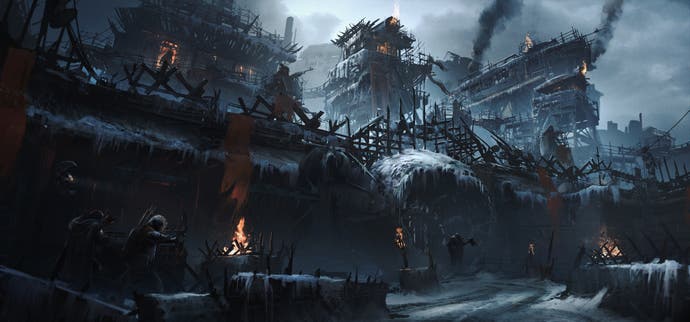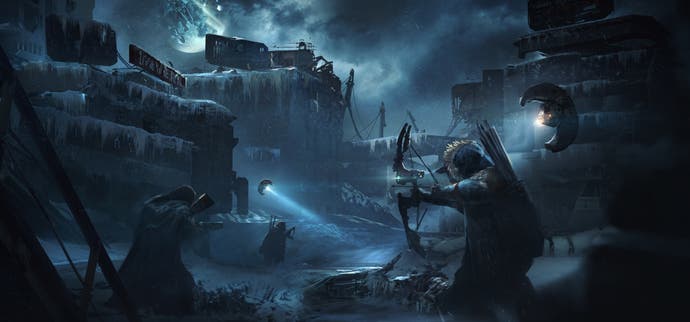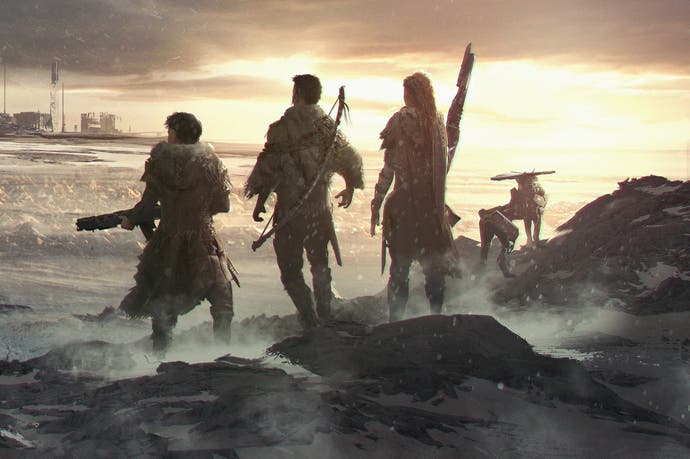Scavengers is an ambitious "co-opetition" shooter inspired by Halo 5's Warzone
Spartan.
Warzone was for me the best thing about Halo 5. This player versus environment versus player mode saw first-person shooter carnage across enormous maps - the biggest the Halo series had ever seen - with computer-controlled enemies and player-controlled spartans going at it.

So, I'm intrigued by the idea of Scavengers, a game whose developers list Halo 5's Warzone as an inspiration, and a game whose developers actually made Halo 5's Warzone.
Midwinter Entertainment is a small, 16-person Kirkland, Washington-based studio founded in December 2016 by some of the people who made Halo at 343 Industries - the Microsoft-owned developer based just down the road in Redmond (completing the triumvirate of Halo makers in the wet and cold of the Pacific Northwest is Destiny developer Bungie, which is based just down the other road in Bellevue).
Josh Holmes, ex-studio head and creative director for the Halo franchise at 343, is clearly proud of Warzone. When he speaks of it he does so with a sense of satisfaction, although I sense the lingering effects of seven years spent pouring blood, sweat and tears into the reimagining of Master Chief in a post-Bungie era.
There is also an admission that Warzone didn't quite hit the intended mark. That is, it didn't end up providing the experience its creators hoped it would. A lot of this had to do with the inevitable focus on PvP in various choke points across the Warzone maps. PvP ended up being the dominant strategy. In fact, it became the only strategy - if you wanted to win. PvP was not so much blended with PvE, more it shot it in the face then teabagged its corpse.
"Ultimately Warzone got to the place where the dominant strategy for winning was PvP," Holmes tells Eurogamer. "It basically came down to, you have choke points, you're trying to kill players and stop them from moving forward in the map. A lot of what Warzone ended up being was very repetitive events within the match that over time could be gamed out, which created this dominant competitive strategy. This wasn't the intention when we started building that mode. It was intended to be a mode that was more of an even balance between the more campaign or Firefight-centric PvE with an element of competitive PvP."

Scavengers, which is in the early stages of production but well on its way to being playable at some point in 2018, aims to offer a smoother player versus computer versus player blend - across a ginormous map packed with more players and AI-controlled enemies than Warzone could dream of. Where Warzone maxed out the Xbox One with 50 basic AIs and 24-players split into two teams, Scavengers boasts the potential for hundreds of AI, each with their own set of behaviours and, well, as many teams of players as the developers reckon is needed to craft the experience they're going for.
"We're trying to achieve a better balance," Holmes explains. "We don't want the game of Scavengers to become one where killing players is the dominant strategy in the game, where if you're not tremendously skilled at killing other players, that you can feel like you're contributing to your team. We want to create the opportunity for players to contribute in a myriad of different ways on the battlefield."
Holmes calls Scavengers a "co-opetition" third-person survival shooter. Teams of four players are spat out into a near future frozen wasteland and tasked with surviving, exploring and fighting computer-controlled factions as well as other teams of players, with the ultimate goal of escaping via an extraction point.

Each match boils down to three phases. First up is the build phase, which sees players equip their scavengers, scout the game world and plan their moves. The second phase is the "hunt", which tasks players with killing enemies, completing objectives and gathering resources. And the third and final phase of the game is called "extract". Here the teams try to find and defend launch zones from which they escape - hopefully with a decent haul of items.
The survival elements are as you'd expect of a game set in the freezing cold. You must keep your character warm and well fed and hydrated throughout the match experience ("Those are elements in the game today. We'll see if they survive until release!" Holmes quips). You also have just one "life" in a match. You can revive downed teammates, but once you're dead, you're dead.
"We want to have this sense of peril as you're exploring the world," Holmes adds. "It's a dangerous world and we want that to come through the entire experience."
All the while, you'll be gathering resources you hope to escape the map with, craft weapons from scavenged resources and shooting enemies to bits.
Speaking of enemies, there are three AI-controlled factions in the game: the Scourge, the Outlanders and the Salient. The Scourge are animals infected by a mystery virus, the Outlanders are typical human enemies, while the Salient are AI-controlled... AI. Each faction behaves differently, and there's a strategy to their potential engagement. Sit back and let the factions fight each other, or get stuck in? It's up to you and your teammates. But be warned: there will be hundreds of AI enemies in the Scavengers game world. You are not alone.
"You're going to learn how best to approach these different threats," Holmes says. "You see the world not just reacting to you but reacting to itself. As you have this Scourge horde occupying areas around the map, they're able to interact with the Outlanders who are defending their territory. If they're able to overcome those Outlanders, they're able to multiply in their numbers. That's one thing the player needs to deal with as they're exploring.
"The Scourge is a twisted form of wildlife. When you're aware of the presence of the Scourge, it becomes something that strikes fear into the player. We want to create this sense of vulnerability among the players, where the players need to rely on one another as they're exploring the world and dealing with these threats.
"And we want to create this sense of openness and exploration, punctuated by moments of intense combat, as opposed to a frenetic, constant combat-focused experience. Do you ambush players? As a team you're always having to keep a watchful eye for opposition teams."

Then there are enemy players to contend with. Holmes won't say how many players can inhabit the game world at the same time, in part because the team has yet to work that out yet, but I get the impression the developers are shooting for hitting that sweet spot where there's enough teams to create a sense of tension about what's around the corner as well as dread at the prospect of an ambush. But exploration is part of the process, too. Too many players won't make for a fun game. Too few could be boring.
The whole thing is powered by SpatialOS, a technology built by UK company Improbable, which is also funding development of Scavengers. The idea is an enormous game world is made possible by splitting it up into sections, each running on its own server. Transitions between each section of the world is seamless - so seamless in fact that players won't encounter any loading. The idea is more players than would otherwise be possible can inhabit the game world at once, and that game world is bigger than one fulled by a single server.
Bigger isn't always better, of course - that's a lesson Holmes learnt from PlayStation 3 exclusive MAG - a shooter that supported a whopping 256 players.
"It was an amazing technical accomplishment," Holmes says, "but what I learned in that experience was that doesn't necessarily make for a great shooter in a multiplayer environment. Typically you might face a single sniper coming around the corner and you can deal with that, but if there are 12 snipers all sitting there waiting for anybody to cross around the corner and then taking them out, it ruins the experience. More is not necessarily better."
So, hitting the sweet spot of map size, player and AI count will be key to Scavengers' success. But there are other benefits to the SpatialOS tech.
Holmes talks about players causing a tree to fall, thus creating new cover in the game world. Usually such a thing would have to be a heavily scripted event because of the technical limitations that come from running a game on a single server or client-based architecture. "It's very challenging to recompute pathfinding on the fly," Holmes says. "That's an incredibly intensive problem."
Midwinter plans to use SpatialOS to handle these kinds of calculations. "The pathfinding can be recalculated on a separate worker and then fed back into the game experience," Holmes says, "which then allows the AI to be much more reactive to dynamic events within the world."
And imagine this: players and AI leave footprints in the snow, which remain until they are eventually filled out. "Being able to track the footprints of anyone who's gone through an area - of any AI that might have transitioned through an area and being able to then use that as a means to track - that's another thing we're talking about that could be really interesting," Holmes says. "You could see, okay, there's been a group of players here, and the footprints lead off in this direction. Lets follow these footprints and hunt them down."
Governing the action is the Game Director, which is a kind of Left 4 Dead-style game master that tweaks the action depending on how players are getting on. The Game Director understands where the players are in relation to one another, so when it offers different objectives to each of the different teams, it wonders, how much do I want to pull these players away from each other? How much do I want to bring them together? It knows bringing players together increasing the likelihood of conflict, but if that's what the session needs, that's what it'll get. "It's creating the ebb and flow of action over the course of the session and trying to maintain the ideal feel to the game that represents the intention of our team," Holmes explains.

It's important to note that Scavengers is still in the early stages of production, and so it's hard to make a confident statement about its potential. We don't even have a single screenshot to go on at this stage. But it's clear it's an ambitious project for this small, tight-knit group of developers who have plenty of experience making big-budget games under a great deal of pressure.
It's also clear Midwinter has big hopes for Scavengers. Already there's talk of it being a game as a service - what game isn't these days? - which means daily, weekly, monthly and even quarterly challenges designed to keep players coming back for more. There's a whole character progression that exists outside the match gameplay. Progression is the name of the game, the never-ending quest for self-improvement, the insatiable hunger for virtual numbers to go up up and up.
I keep coming back to Warzone as I wonder about Scavengers' potential. Holmes is at pains to stress this new game is not Warzone 2.0, nor is it an attempt to right the wrongs of Halo 5's best mode. It is something entirely different, he insists. But it's easy to trace a line from Warzone to Scavengers, if not in terms of eventual gameplay experience, then in terms of ambition. Warzone, essentially, aimed to successfully fuse PvP with PvE. Ultimately it failed in this, although the upshot was for me a lot of fun. Scavengers takes the foundation of Warzone and runs with it.
I also detect elements of the Battle Royale genre here. Scavengers is not a last man standing game, but elements of the large scale world you get in the Battle Royale genre are present and correct - with the added spice that comes from all sorts of lifeforms - hostile and otherwise.
Scavengers, then, is certainly one to watch. If the developers can nail the core match experience and keep it fresh enough to keep players coming back for more, it could have a hit on its hands.






.png?width=291&height=164&fit=crop&quality=80&format=jpg&auto=webp)



